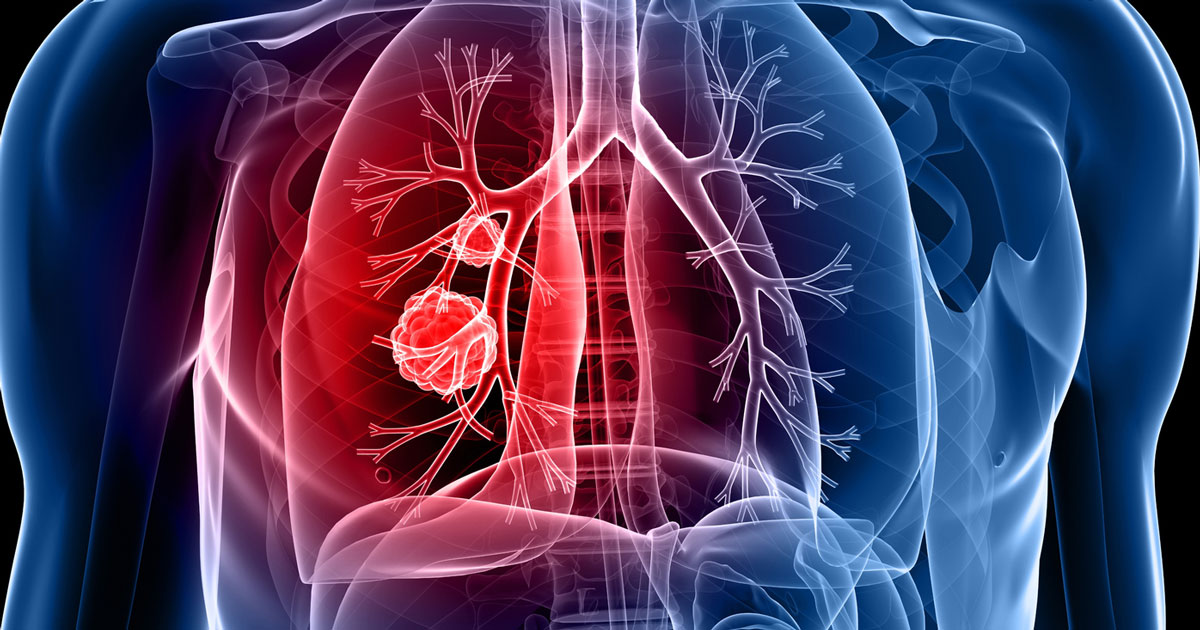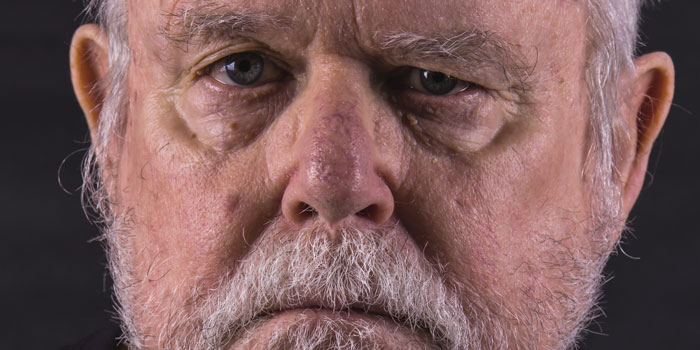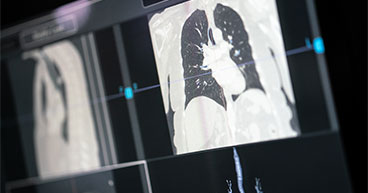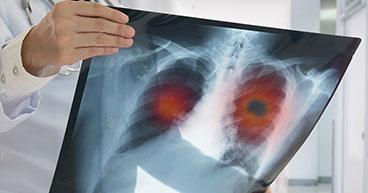
Coughing. Wheezing. Shortness of breath. These are the symptoms that may come to mind when you think about signs of lung cancer. But while these are some of the common symptoms of lung cancer, the disease may also cause other less well-known signs.
Hoarseness, persistent shoulder pain and even nausea may be indicators of lung cancer. These lesser-known symptoms may be mistaken for other conditions—particularly for nonsmokers, who may not be looking for signs of lung cancer.
Lung cancer is the deadliest form of the disease in the United States, accounting for nearly 132,000 deaths (22 percent) in 2021, according to the American Cancer Society. Eight in 10 lung cancer deaths are linked to tobacco use, but the disease is being diagnosed in a growing number of nonsmokers. One U.K. study found the percentage of lung cancer patients who never smoked more than doubled from 2008 to 2014—from 13 percent to 28 percent—due to radon, air pollution and other factors.
To help you recognize the surprising signs of lung cancer, this article details the symptoms you should bring to your health care provider’s attention:
- Back pain
- Shoulder pain
- Dizziness
- Clubbed fingers and toes
- Raspy voice
- Eye changes
- Stomach issues
- Swelling or bloating
If you believe you may be experiencing signs of lung cancer and want to schedule a consultation, or if you’re interested in a second opinion on your diagnosis and treatment plan, call us or chat online with a member of our team.
Back pain
In 2009, George Alan R. began experiencing back pain that wouldn’t go away. Although his doctor first thought muscle spasms were causing the discomfort, a follow-up chest X-ray and MRI revealed a golf ball-sized tumor on his right lung.
Because his cancer was caught early, he underwent chemotherapy and radiation therapy treatments at Cancer Treatment Centers of America® (CTCA). Today, he’s enjoying life in retirement with Susan, his wife of nearly 40 years—traveling, gardening and doing projects around the house.
“I continue to return to CTCA® for checkups,” he says. “I do live with fear the cancer will come back, but I try to think positively. I intend to put cancer out of my life and move on. There’s reason to be optimistic.”
Alan’s experience spotlights the connection between lung cancer and back pain. This lesser-known symptom is sometimes the first sign of a tumor and may indicate the cancer has spread beyond its origin—to the bones and spine.
In fact, up to 25 percent of lung cancer patients experience back pain.
Like Alan, some people may first turn to medications or other therapies for relief. But when those approaches don’t work, doctors may recommend an X-ray or MRI to check for lung cancer or determine another cause.

Shoulder pain
Shoulder pain or shoulder blade pain that worsens during coughing, laughing or deep breathing may be caused by a tumor putting pressure on surrounding areas. The tumor may also cause spinal cord compression, leading to pain in the back, neck and shoulders.
For some people, the pain may come and go, be mild or intense, or even make sleeping, eating or daily activities difficult.
Regardless of the cause, type or severity of any shoulder pain you experience, it’s crucial to discuss it with your health care provider—especially if the pain persists.
Dizziness
Advanced-stage lung cancer may cause neurological symptoms because of its effects on other parts of the body or because it’s spread to distant sites, including the brain.
These symptoms may include dizziness and headaches that are mistaken for other maladies. Patients with certain types of lung cancer may also experience balance issues and feel unsteady on their feet, putting them at risk for falls and injuries.
Lung cancer-related dizziness and balance issues typically result from dehydration, anemia or a tumor that has spread to the brain.

Clubbed fingers or toes
Another surprising symptom of lung cancer is a change in the appearance of fingers or toes—known as “clubbed fingers” or “clubbed toes”—due to chronically low levels of oxygen in the blood.
When this happens, the tips of the fingers or toes bulge and may become warm and/or discolored. “Nail clubbing”—where the nail curves down—may also make the nail look like it’s an upside-down spoon or appear to be floating and not attached to the finger.
To diagnose the condition, your doctor may perform a “clubbed finger test” such as a so-called “Schamroth window test”—in which two fingers are held back-to-back against each other. A diamond-shaped window space normally appears between the nail bed and the nails of the fingers. With clubbed fingers, this space is missing.
If you have nail clubbing, your doctor may order a chest X-ray or CT scan to look for signs of lung cancer.
Raspy voice
Hoarseness or a raspy voice may stem from irritation or injury to the vocal cords. But these are also a lesser-known symptom of lung cancer, which may affect I the vocal cords because a tumor is pressing on a nerve.
You may notice that your voice sounds:
- Raspy
- Husky
- Strained
- Breathy
- Weak
- Inconsistent
- Tired
- Higher or lower than normal
Eye changes
Non-small cell lung cancer (NSCLC) may affect other areas of the body, including the eyes, by either the spread or development of tumors.
NSCLC tumors may prompt changes in the eyes as a result of nerve damage that leads to a condition known as Horner syndrome. This often affects one side of the face, causing a droopy eyelid and a reduction in the size of the pupil.
Horner syndrome affects up to 50 percent of patients with a so-called Pancoast tumor—a type of lung cancer that develops in the top portion of the lung and sometimes triggers multiple symptoms when it spreads to the spine or chest wall.
Pancoast tumors, also called superior pulmonary sulcus tumors, account for fewer than five in 100 cases of lung cancer. These tumors may spread to the ribs, spinal cord and chest, where they tend to put pressure on or damage nerves running from the upper chest into the neck and arms.

Stomach issues
Nausea and constipation are often the result of dietary issues or gastrointestinal disorders. But they may be an early sign of lung cancer. That’s because lung cancer may affect the stomach by causing hypercalcemia, characterized by too much calcium in the blood.
About one in five cancer patients experience this condition, which may cause various stomach issues (vomiting, decreased appetite, abdominal pain), as well as increased thirst, urinary urgency, headaches, fatigue, confusion, kidney problems and seizures.
Swelling or bloating
Lung cancer may also cause unexplained swelling, bloating or a feeling of fullness, because cancer sometimes causes fluid retention and a condition known as superior vena cava syndrome (SVCS). This symptom is especially common in women.
SVCS results from a blockage or narrowing of the superior vena cava, a major vein that funnels blood from the head and upper body to the heart. If a tumor presses on this vein, a potentially life-threatening blockage may develop, causing swelling of both arms and the breasts, trouble swallowing, enlarged veins in the head and neck, chest pain, cough, shortness of breath and other symptoms.
As with the other surprising signs and symptoms of lung cancer, unexplained swelling, bloating or stomach issues shouldn’t be ignored. See a doctor right away if any of these symptoms persist and don’t go away on their own.
Lung cancer care at CTCA
At the Lung Cancer Centers at each of our CTCA hospitals, our singular focus enables our oncologists to stay up to date on new and emerging treatments and technologies, allowing us to help you make informed decisions about your options while also considering integrative strategies designed to treat the symptoms of the disease and the side effects of treatment. Having a team of lung cancer experts collaborating daily, all under one roof, allows us to assemble a detailed treatment plan more quickly and efficiently.
Our Lung Cancer Centers are located at:
Each patient’s Lung Cancer Center care team is led by a medical oncologist and coordinated by a care manager who handles the logistics—from scheduling appointments and getting test results to getting questions answered in a timely way—so patients can focus on healing and getting back to their lives. Our lung cancer pathologists also play a key role in diagnosing and staging the disease, to better identify the treatment options available.
Depending on your lung cancer type, stage and recommended treatment plan, your care team may include surgical and/or radiation oncologists, interventional pulmonologists, oncology nurses and a host of supportive care clinicians, all collaborating in real time to craft a personalized, comprehensive care plan tailored to you and your needs.
If you believe you may be experiencing signs of lung cancer and want to schedule a consultation, or if you’re interested in a second opinion on your diagnosis and treatment plan, call us or chat online with a member of our team.



